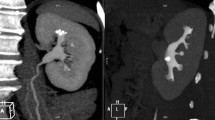Abstract
The objective of this study is to evaluate the average radiation exposure in children with renal stones before SWL treatment. Mean radiation exposure values were evaluated in 110 children before SWL treatment. While some children referred to the emergency department (ED) with colic pain, remaining cases referred to outpatient department (OD). Although low-dose NCCT was performed in ED; KUB and abdominal sonography were first performed in other cases referring to OD where CT has been applied if needed. The type of imaging modality used and the mean radiation exposure were evaluated and comparatively evaluated with respect to the department referred, patient as well as stone related parameters. 49 children referred to ED and 61 children referred to OD. Mean stone size was 7.24 ± 0.29 mm. 62 cases had opaque stones. Mean radiation exposure values were higher in children referring to ED than the other cases. However, there was no significant difference between the two groups regarding the mean number of KUB, IVU and sonographic evaluation performed prior to SWL management. There was a significant correlation between the mean radiation exposure and the stone size as well degree of hydonephrosis in a positive manner. Although a significant correlation was present between the mean radiation exposure and stone opacity in a negative manner; there was no correlation with respect to the other related parameters. Unnecessary use of X-ray based imaging modalities in children could be effectively avoided using KUB and US combination beginning from the diagnostic phase of stone disease.

Similar content being viewed by others
Abbreviations
- ALARA:
-
As low as reasonably achievable
- CT:
-
Computed tomography
- ED:
-
Emergency department
- HU:
-
Hounsfield unit
- IVU:
-
Intravenous urography
- ICRP:
-
International Commission on Radiological Protection
- KUB:
-
Kidney-ureter-bladder
- mSv:
-
millisievert
- NCCT:
-
Noncontrast computed tomography
- OD:
-
Outpatient department
- SWL:
-
Shock wave lithotripsy
- UTI:
-
Urinary tract infection
- USG:
-
Ultrasonography
References
Sarica K (2008) Medical aspect and minimal invasive treatment of urinary stones in children. Arch Ital Urol Androl 80:43–49
Kroovand RL (1997) Pediatric urolithiasis. Urol Clin North Am 24:173–184
Minevich E (2001) Pediatric urolithiasis. Pediatr Clin North Am 48:1571–1585
Erbagcı A, Erbagcı BA, Yılmaz M et al (2003) Pediatric urolithiasis. Scand J Urol Nephrol 37:127–133
Koyuncu H, Yencilek F, Erturhan S et al (2011) Clinical course of pediatric urolithiasis: follow-up data in a long-term basis. Int Urol Nephrol 43:7–13
Thalgott M, Kurtz F, Gschwend JE et al (2015) Diagnostic imaging of urolithiais. Current recommendations and new developments. Urologe Ausg A 54:948–955
Preston DL, Cullings H, Suyama A et al (2008) Solid cancer incidence in atomic bomb survivors exposed in utero or as young children. J Natl Cancer Inst 100:428
Katz DS, Scheer M, Lumerman JH et al (2000) Alternative or additional diagnoses on unenhanced helical computed tomography for suspected renal colic: experience with 1000 consecutive examinations. Urology 56:53–57
Hernanz-Schulman M, Goske MJ, Bercha IH et al (2011) Pause and pulse: ten steps that help manage radiation dose during pediatric fluoroscopy. AJR Am J Roentgenol 197:475
Strauss KJ, Kaste SC (2006) The ALARA (as low as reasonably achievable) concept in pediatric interventional and fluoroscopic imaging: striving to keep radiation doses as low as possible during fluoroscopy of pediatric patients—a white paper executive summary. Radiology 240:621
Hyams ES, Shah O (2010) Evaluation and follow-up of patients with urinary lithiasis: minimizing radiation exposure. Curr Urol Rep 11:80–86
Johnson PB, Bahadori AA, Eckerman KF et al (2011) Response functions for computing absorbed dose to skeletal tissues from photon irradiation—an update. Phys Med Biol 56:2347–2365
Lee C, Lodwick D, Hurtado J et al (2010) The UF family of reference hybrid phantoms for computational radiation dosimetry. Phys Med Biol 55:339–363
Recommendations of the international commission on radiological protection 2007 (2007) ICRP publication 103. Ann ICRP 37:1–332
Gkanatsios NA, Huda W (1997) Computation of energy imparted in diagnostic radiology. Med Phys 24:571–579
Faerber GJ (2001) Pediatric urolithiasis. Urology 11:385–389
Spivacow FR, Negri AL, del Valle EE et al (2008) Metabolic risk factors in children with kidney stone disease. Pediatr Nephrol 23:1129–1133
Pietrow PK, Pope JC, Adams MC et al (2002) Clinical outcome of pediatric stone disease. J Urol 167:670–673
Milliner DS, Murphy ME (1993) Urolithiasis in pediatric patients. Mayo Clin Proc 68:241–244
Noe HN (2000) Hypercalciuria and pediatric stone recurrences with and without structural abnormalities. J Urol 164:1094–1096
Kluner C, Hein PA, Gralla O et al (2006) Does ultra-low-dose CT with a radiation dose equivalent to that of KUB suffice to detect renal and ureteral calculi? J Comput Assist Tomogr 30:44–50
Ripolles T, Agramunt M, Errando J et al (2004) Suspected ureteral colic: plain film and sonography vs unenhanced helical CT. A prospective study in 66 patients. Eur Radiol 14:129–136
Strauss KJ, Goske MJ (2011) Estimated pediatric radiation dose during CT. Pediatr Radiol 41:472–482
Ripolles T, Martinez-Perez MJ, Vizuete J et al (2013) Sonographic diagnosis of symptomatic ureteral calculi: usefulness of the twinkling artifact. Abdom Imaging 38:863–869
Pepe P, Motta L, Pennisi M et al (2005) Functional evaluation of the urinary tract by color-Doppler ultrasonography (CDU) in 100 patients with renal colic. Eur J Radiol 53:131–135
Jandaghi AB, Falahatkar S, Alizadeh A et al (2013) Assessment of ureterovesical jet dynamics in obstructed ureter by urinary stone with color Doppler and duplex Doppler examinations. Urolithiasis 41:159–163
Author information
Authors and Affiliations
Corresponding author
Ethics declarations
Funding
This study was not funded by any institution.
Conflict of interest
Bilal Eryildirim, Ozlem Turkoglu, Cemal Goktas, Ovunc Kavukoglu, Rasim Guzel and Kemal Sarica declares that he has no conflict of interest.
Ethical approval
All applicable international, national, and/or institutional guidelines for the care and use of animals were followed.
Rights and permissions
About this article
Cite this article
Eryildirim, B., Turkoglu, O., Goktas, C. et al. Radiologic evaluation of children prior to SWL: to what extent they are exposed to radiation?. Urolithiasis 46, 485–491 (2018). https://doi.org/10.1007/s00240-017-1008-8
Received:
Accepted:
Published:
Issue Date:
DOI: https://doi.org/10.1007/s00240-017-1008-8




